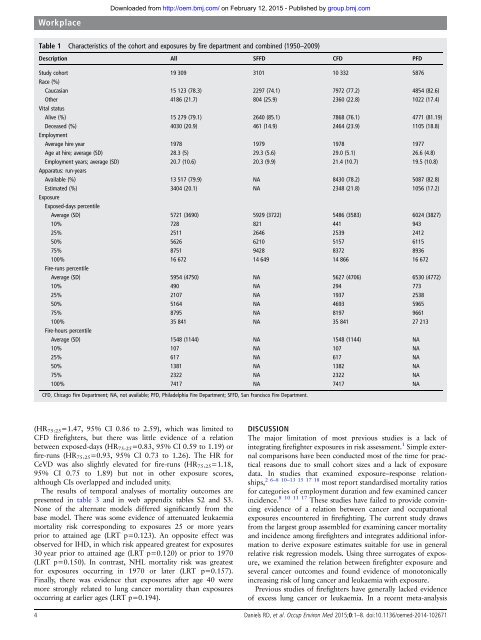Daniels-et-al-(2015)
Daniels-et-al-(2015)
Daniels-et-al-(2015)
You also want an ePaper? Increase the reach of your titles
YUMPU automatically turns print PDFs into web optimized ePapers that Google loves.
Downloaded from http://oem.bmj.com/ on February 12, <strong>2015</strong> - Published by group.bmj.com<br />
Workplace<br />
Table 1 Characteristics of the cohort and exposures by fire department and combined (1950–2009)<br />
Description All SFFD CFD PFD<br />
Study cohort 19 309 3101 10 332 5876<br />
Race (%)<br />
Caucasian 15 123 (78.3) 2297 (74.1) 7972 (77.2) 4854 (82.6)<br />
Other 4186 (21.7) 804 (25.9) 2360 (22.8) 1022 (17.4)<br />
Vit<strong>al</strong> status<br />
Alive (%) 15 279 (79.1) 2640 (85.1) 7868 (76.1) 4771 (81.19)<br />
Deceased (%) 4030 (20.9) 461 (14.9) 2464 (23.9) 1105 (18.8)<br />
Employment<br />
Average hire year 1978 1979 1978 1977<br />
Age at hire; average (SD) 28.3 (5) 29.3 (5.6) 29.0 (5.1) 26.6 (4.8)<br />
Employment years; average (SD) 20.7 (10.6) 20.3 (9.9) 21.4 (10.7) 19.5 (10.8)<br />
Apparatus: run-years<br />
Available (%) 13 517 (79.9) NA 8430 (78.2) 5087 (82.8)<br />
Estimated (%) 3404 (20.1) NA 2348 (21.8) 1056 (17.2)<br />
Exposure<br />
Exposed-days percentile<br />
Average (SD) 5721 (3690) 5929 (3722) 5486 (3583) 6024 (3827)<br />
10% 728 821 441 943<br />
25% 2511 2646 2539 2412<br />
50% 5626 6210 5157 6115<br />
75% 8751 9428 8372 8936<br />
100% 16 672 14 649 14 866 16 672<br />
Fire-runs percentile<br />
Average (SD) 5954 (4750) NA 5627 (4706) 6530 (4772)<br />
10% 490 NA 294 773<br />
25% 2107 NA 1937 2538<br />
50% 5164 NA 4693 5965<br />
75% 8795 NA 8197 9661<br />
100% 35 841 NA 35 841 27 213<br />
Fire-hours percentile<br />
Average (SD) 1548 (1144) NA 1548 (1144) NA<br />
10% 107 NA 107 NA<br />
25% 617 NA 617 NA<br />
50% 1381 NA 1382 NA<br />
75% 2322 NA 2322 NA<br />
100% 7417 NA 7417 NA<br />
CFD, Chicago Fire Department; NA, not available; PFD, Philadelphia Fire Department; SFFD, San Francisco Fire Department.<br />
(HR 75:25 =1.47, 95% CI 0.86 to 2.59), which was limited to<br />
CFD firefighters, but there was little evidence of a relation<br />
b<strong>et</strong>ween exposed-days (HR 75:25 =0.83, 95% CI 0.59 to 1.19) or<br />
fire-runs (HR 75:25 =0.93, 95% CI 0.73 to 1.26). The HR for<br />
CeVD was <strong>al</strong>so slightly elevated for fire-runs (HR 75:25 =1.18,<br />
95% CI 0.75 to 1.89) but not in other exposure scores,<br />
<strong>al</strong>though CIs overlapped and included unity.<br />
The results of tempor<strong>al</strong> an<strong>al</strong>yses of mort<strong>al</strong>ity outcomes are<br />
presented in table 3 and in web appendix tables S2 and S3.<br />
None of the <strong>al</strong>ternate models differed significantly from the<br />
base model. There was some evidence of attenuated leukaemia<br />
mort<strong>al</strong>ity risk corresponding to exposures 25 or more years<br />
prior to attained age (LRT p=0.123). An opposite effect was<br />
observed for IHD, in which risk appeared greatest for exposures<br />
30 year prior to attained age (LRT p=0.120) or prior to 1970<br />
(LRT p=0.150). In contrast, NHL mort<strong>al</strong>ity risk was greatest<br />
for exposures occurring in 1970 or later (LRT p=0.157).<br />
Fin<strong>al</strong>ly, there was evidence that exposures after age 40 were<br />
more strongly related to lung cancer mort<strong>al</strong>ity than exposures<br />
occurring at earlier ages (LRT p=0.194).<br />
4<br />
DISCUSSION<br />
The major limitation of most previous studies is a lack of<br />
integrating firefighter exposures in risk assessment. 1 Simple extern<strong>al</strong><br />
comparisons have been conducted most of the time for practic<strong>al</strong><br />
reasons due to sm<strong>al</strong>l cohort sizes and a lack of exposure<br />
data. In studies that examined exposure–response relationships,<br />
26–8 10–13 15 17 18 most report standardised mort<strong>al</strong>ity ratios<br />
for categories of employment duration and few examined cancer<br />
incidence. 8 101117 These studies have failed to provide convincing<br />
evidence of a relation b<strong>et</strong>ween cancer and occupation<strong>al</strong><br />
exposures encountered in firefighting. The current study draws<br />
from the largest group assembled for examining cancer mort<strong>al</strong>ity<br />
and incidence among firefighters and integrates addition<strong>al</strong> information<br />
to derive exposure estimates suitable for use in gener<strong>al</strong><br />
relative risk regression models. Using three surrogates of exposure,<br />
we examined the relation b<strong>et</strong>ween firefighter exposure and<br />
sever<strong>al</strong> cancer outcomes and found evidence of monotonic<strong>al</strong>ly<br />
increasing risk of lung cancer and leukaemia with exposure.<br />
Previous studies of firefighters have gener<strong>al</strong>ly lacked evidence<br />
of excess lung cancer or leukaemia. In a recent m<strong>et</strong>a-an<strong>al</strong>ysis<br />
<strong>Daniels</strong> RD, <strong>et</strong> <strong>al</strong>. Occup Environ Med <strong>2015</strong>;0:1–8. doi:10.1136/oemed-2014-102671


